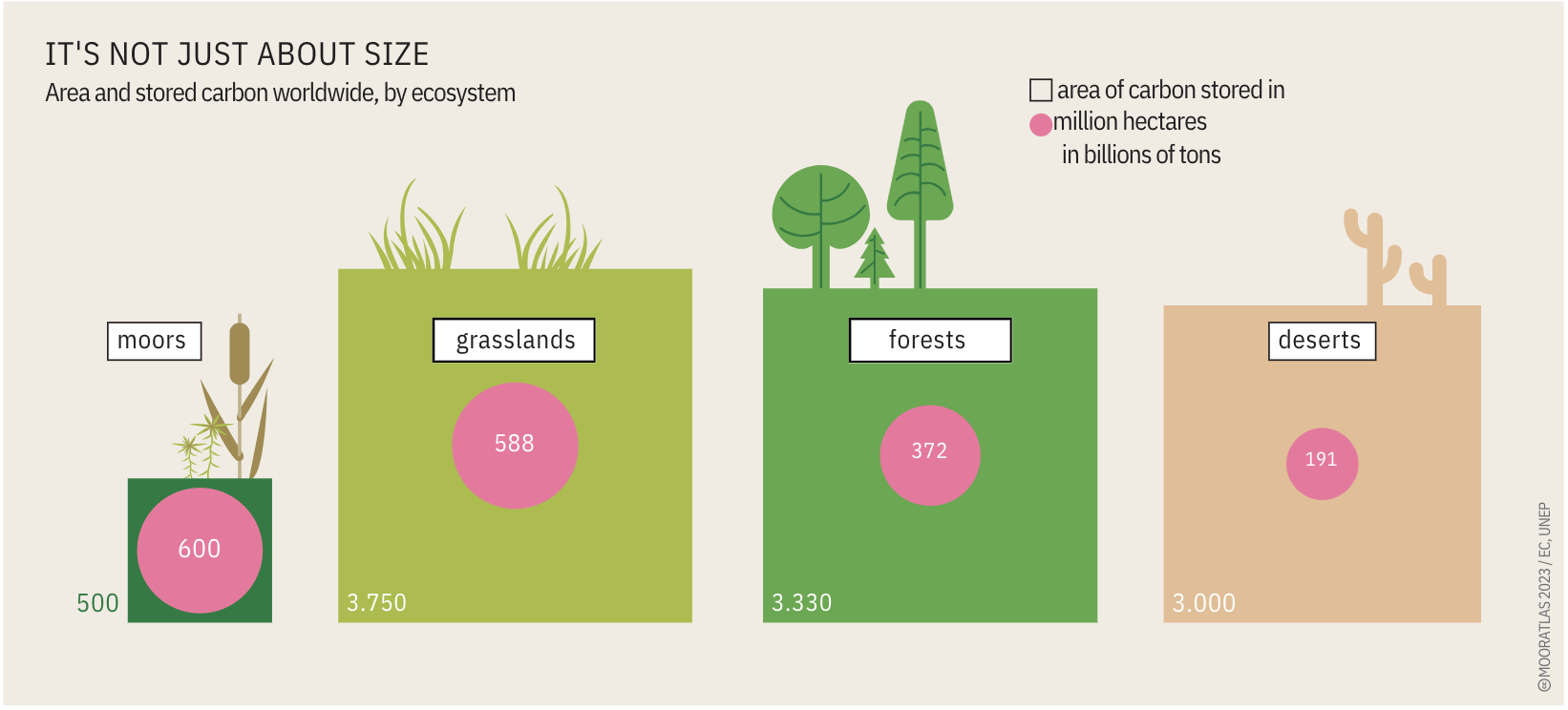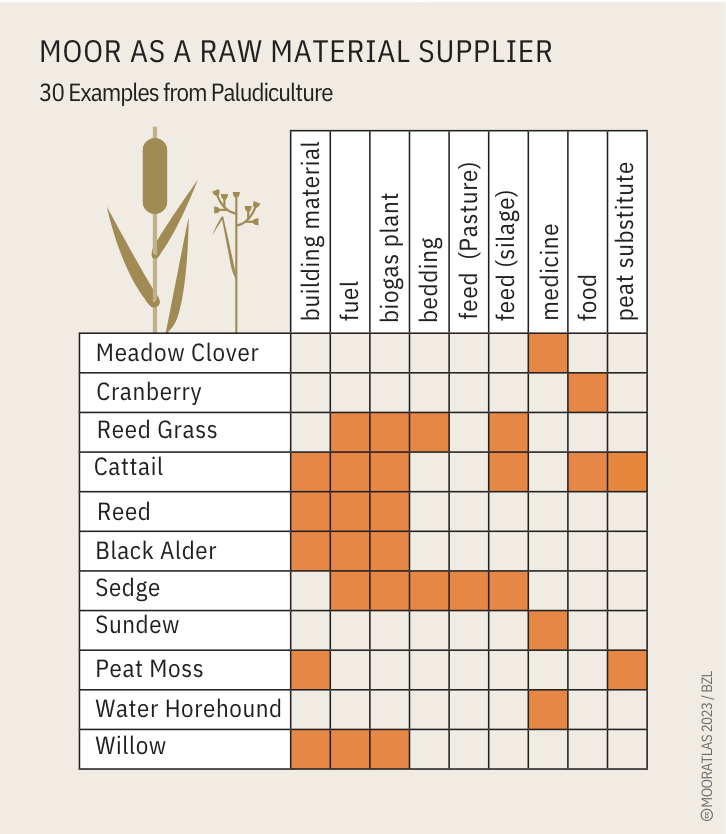Paludiculture - A Climate-Friendly Growth Market
Moorlands: Where Myth Meets Climate Science
Moorlands have long been shrouded in mist and mystery. From the phantom hound of Arthur Conan Doyle’s The Hound of the Baskervilles to Germanic legends of swamp-dwelling spirits, these wetlands were once seen as eerie no-go zones. But today, Germany’s moors are swapping their spooky reputation for a new role: climate heroes. Beneath their soggy surfaces lies a potent carbon vault—peat, a dense layer of partially decomposed plants that’s been stockpiling CO₂ for millennia.
Eichwerder Moorwiesen, Berlin
Why Do They Matter? From Carbon Vaults to Climate Crisis
Healthy moorlands are Earth’s unsung climate allies. Here’s the science: in waterlogged moors, dead plants pile up faster than they can decompose. Without oxygen, this organic matter turns into peat—a carbon-rich “pickle” that locks away 600 billion tons of CO₂ globally (twice as much as all forests combined). But drain these wetlands for construction, agriculture, or peat extraction, and the magic flips. Exposed to air, peat rots, releasing centuries of stored carbon as CO₂.
🔍Germany’s dirty secret: Over 90% of Germany’s moorlands have been drained, emitting 53 million tons of CO₂ annually—equivalent to 6% of the country’s total emissions.1
What’s driving the destruction?
Agriculture: EU subsidies fuel drainage for crops like maize and pastureland. Germany’s drained peatlands for farming emit 37 million tons of CO₂ yearly (70% of total moor emissions)1 [Mooratlas 2023, p. 28].
Peat extraction: Despite sustainable alternatives, peat remains a staple in gardening soils. Germany alone extracts 8 million cubic meters annually, destroying habitats and releasing CO₂1 [Mooratlas 2023, p. 26].
Urban sprawl: Berlin’s expansion since the 18th century drained wetlands for settlements. Today, less than 1% of Brandenburg’s original moorlands remain intact1 [Mooratlas 2023, p. 20].
Let’s explore how Germany is turning these misunderstood landscapes into hubs of sustainable innovation.
Paludiculture: A Climate-Friendly Growth Market
Paludiculture—wetland farming—turns swampy soil into a resource. At the recent Bau Messe, the Paludi-Allianz (spearheaded by ToMOORow) showcased how this approach is revitalizing Berlin-Brandenburg’s degraded peatlands. Their vision: rewet 50,000+ hectares by 2030 and build a supply chain for “Made in Wetland” construction materials.
Building materials born in the bog:
Reed thatch (Swamp Grass): A 5,000-year-old insulation superstar. Startups like ReetConnect harvest reeds from rewetted moors, creating roofs that last 50+ years. Why it works: Reed’s hollow stems trap air, providing natural thermal insulation (up to 0.04 W/mK—better than fiberglass). It’s also fire-resistant and biodegradable1 3.
Typha or Cattail (Swamp Plant): Brandenburg’s Typha Tech processes these wetland plants into lightweight boards for walls and furniture. Why it works: Typha fibers have high tensile strength and moisture resistance. Boards made from cattail require 90% less energy to produce than concrete and sequester 3.2 tons of CO₂ per ton of material2 4.
Sphagnum moss (Peat Moss): Dubbed “green concrete,” Fraunhofer Institute trials show it outperforms mineral wool in thermal insulation. Why it works: Sphagnum’s cellular structure retains water and air, offering 0.03 W/mK conductivity while regulating indoor humidity5.
Challenges: Why Paludiculture Isn’t a Walk in the (Wet) Park
While paludiculture offers immense potential, scaling it up isn’t all sunshine and cattails. Here’s why:
Harvesting Headaches: Heavy machinery sinks in swampy soil. Amphibious harvesters exist, but they’re pricey. Winter freezes (when moors firm up) are becoming rarer due to climate change, reducing harvest timeframe1 [Mooratlas 2023, p. 34].
Policy Potholes: EU agricultural subsidies still favor drained farmland over wetland crops. Redirecting these funds requires political will—something the Paludi-Allianz is pushing for at Bau Messe and beyond1 [Mooratlas 2023, p. 28].
Market Hesitation: Builders and architects are wary of untested materials. Convincing them to swap concrete for cattail boards demands proof of durability—and a shift in industry norms1 [Mooratlas 2023, p. 36].
Habitat Havoc: Harvesting moor grasses like reeds or typha risks displacing rare species like the Eurasian curlew or moor frog, which rely on these wetlands for nesting. Striking a balance between sustainable harvesting and biodiversity conservation is critical1 [Mooratlas 2023, p. 24].
Why Happy Pigeons Lab Cares
At Happy Pigeons Lab, we’re all about solutions that marry ecology with local impact. Moorlands offer a quadruple win:
Carbon capture: Rewetting just 1.8 million hectares of Germany’s degraded peat could offset 5% of national emissions by 20301.
Material revolution: Imagine Berlin’s future buildings insulated with moss or clad in typha panels—materials that grow back annually.
Community advocacy: We plan to showcase building materials from Paludiculture (stay tuned for 2025!).
In the fight against inequality and overexploitation, the United Nations has committed itself to 17 sustainability goals. Some of these can be achieved with peatland protection.
The Road Ahead: From Policy to Practice
While Germany’s 2023 Moor Protection Strategy is a start, only 1% of EU agricultural subsidies support wetland farming1. The Paludi-Allianz is pushing for:
Policy shifts: Redirecting EU funds from drainage-heavy practices to paludiculture.
Industry partnerships: Connecting builders with moor-grown materials to scale demand.
Public awareness: Debunking the “wasteland” myth—moors are productivity powerhouses when kept wet.
As the Paludi-Allianz motto goes: “Moor muss nass!” (“Moor must stay wet!”).
Sources:
1 Mooratlas 2023 (Heinrich-Böll-Stiftung)
2 EU Horizon 2020, WaterLANDS Restoration Initiative (2023)
3 German Federal Environment Agency, Bauen mit Biomasse (2024)
4 Nature Sustainability, "Cattail Composites in Construction" (2024)
5 Fraunhofer Institute for Building Physics, Bio-Based Insulation Materials (2024)







